Conducting comprehensive fail-safe tests with real drivers in prototype vehicles introduces additional costs and potential hazards (injury and/or damage to assets) for vehicle development programs. Since performance verification of vehicle electronic control systems and on-board active safety technologies is a must, vehicle manufacturers are obliged to seek efficient ways to make it happen. Vehicle dynamics class Driver-in-the-Loop (DIL) simulators are emerging to satisfy this need.
A Simulator is not a Simulator
Human factors DIL simulators (the ubiquitous fixed base and hexapod-based devices that have been on the scene for several decades) allow the reactions of drivers to interventions by a vehicle’s active safety systems and Advanced Driver Assistance Systems (ADAS) to be measured in a safe, consistent lab environment. Inside the protective cocoon of a DIL simulator, there is zero risk of real-world object collision or cabin intrusion. Human factors DIL simulators also enable the surrounding (virtual) environment to be changed at the click of a keypad.
Unfortunately, human factors DIL simulators fall short in at least two important areas: They fail to appropriately engage skilled drivers who have a refined expectation of what a real car should feel like; and they are architecturally better suited to human behavior studies than to vehicle engineering studies. This is why vehicle dynamics DIL simulators are becoming more prevalent amongst vehicle manufacturers and Tier 1 suppliers. In brief, this new, emerging class of DIL simulators allows all the traditional human factors experiments to be conducted as usual, but it also allows exploration of the upper realms of driver behavior and vehicle model / system complexities. A vehicle dynamics DIL simulator (sometimes called an engineering-class simulator) is classified as a vehicle engineering tool, as it is aimed at improving product quality and reducing vehicle development time and expense.
The Wild Card
As a case in point, let’s take a brief look at safety system testing and verification. In many instances industry-wide and regulatory test protocols have been established to assess vehicle safety performance (e.g. Crashworthiness tests are rigidly and consistently defined). But when it comes to evaluating supplemental systems that might interrupt or override a driver’s operational control of a vehicle, sometimes it is the inconsistencies that are of particular interest.
The wild card is, of course, the presence of a live human being who may be acting to control the vehicle in ways that may not synchronize with the intentions of on-board safety systems. In engineering parlance these would be described as active safety situations rather than passive ones. For instance, we may be interested in situations where an electric steering system is intervening to correct a skid, or in a case where an Automated Emergency Braking (AEB) system is faced with unexpected driver or road inputs.
Rigor can be applied to such verification tests in any DIL simulator lab by developing controlled, experimental protocols that specify (or eliminate) variables. But vehicle dynamics DIL simulators shine when a vehicle’s limit performance envelope needs to be safely explored. For example, the standard ISO and SAE severe handling tests include maneuvers that are intended to instigate rollovers. Such open loop tests can be simulated off-line with validated vehicle models, but new layers of human interaction with on-board systems are being added every day. What might be the implications of those layers?
NHTSA’s standard for passenger car Electronic Stability Control (ESC) systems, titled FMVSS 126, establishes the performance and verification requirements for the first mandated systems that have been introduced to actively control vehicle handling. Again, the applicable testing can be simulated off-line – But a vehicle dynamics DIL simulator might prove quite useful for adding realistic layers on top of the baseline verifications. For example, what might be the man-machine interaction implications of a mechanical failure such as a punctured tire or an untimely on-board system failure when the control systems and/or driver are already at a capability limit?
Vehicle Dynamics Ready
The recent and ongoing proliferation of vehicle test protocols – in particular in the domain of safety testing – is certainly an area where vehicle dynamics DIL can help. Other examples are the rise in importance of the New Car Assessment Program (NCAP), Euro NCAP and other, globally equivalent test programs. Crucially, these programs are moving away from a sole focus on passive safety assessment and are beginning to integrate performance acceptance of collision-mitigation technologies such as AEB.
Future steps will surely see vehicles no longer assessed in isolation, but in relation to their interaction with the environment: other vehicles, pedestrians, unexpected interactions or autonomous scenarios wherein vehicles communicate with each other and the surrounding infrastructure. Such complex test scenarios will be more easily and cost-effectively assessed in DIL simulator labs than they could ever be in real (prototype) driving tests, particularly in the early stages of a development program. In key safety areas, such DIL simulation labs will benefit from being “vehicle dynamics and engineering ready” rather than relying on legacy human factors centric simulator technologies.
To learn more about how the various classes of Driver-in-the-Loop simulators can assist with the development of on-board vehicle systems, download our FREE eBook, “Looking down the road: Harnessing the benefits of driving simulator technology”:


